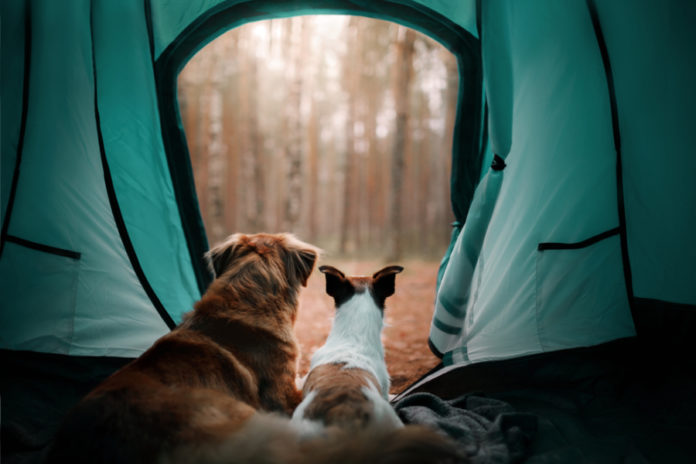Your Guide to Camping with Dogs

Camping is even more enjoyable when you bring your dog along! This comprehensive guide covers everything you need to know to maximize safety and keep things fun.
Taking your dog on a camping trip is an ideal way to bond and enjoy nature together. Before you head out, it’s important to take your dog’s comfort and safety into consideration so your time in the great outdoors isn’t marred by an accident or other problem. Researching your campsite location, packing essential items, and being prepared in case of emergency can help guarantee a fun and relaxing experience for both of you.
Familiarize Yourself with Park Rules and Regulations
 Information about parks and other areas that allow camping is readily available on the internet and social media. Still, it’s a good idea to reach out directly to a park’s office to learn more about any rules and regulations.
Information about parks and other areas that allow camping is readily available on the internet and social media. Still, it’s a good idea to reach out directly to a park’s office to learn more about any rules and regulations.
“We are seeing an increase in visitors bringing their dogs to state parks – part of this is due to the general overall increase in visitation since the pandemic,” says Rachel Hopper, who is with the Minnesota Department of Natural Resources. In addition, a growing number of people have dogs nowadays, and many treat them like family members, which means they travel together more. This is good news, of course, but because more dogs are accompanying their people on camping trips, it becomes more important than ever to follow park rules to keep the experience safe and pleasant for everyone.
- For example, most parks require your dog to be on a leash. “Keeping your dog on a leash at all times is probably the number one thing you can do to keep him safe while you’re camping,” says Andy Bartlett, park manager for Ledges State Park in Madrid, Iowa.
- This includes keeping him leashed while at your campsite, when you’re relaxing outside your tent or RV. This is for his safety as well as that of other dogs and campers. “Don’t let your off-leash dog run up to or approach an on-leash dog,” says Paige Lackey of Project Rustic, an RV tour of Michigan. It doesn’t matter if your dog is friendly; others may be reactive.”
- Dogs should only be taken on designated hiking trails. “Be respectful of everyone you meet on the trail,” adds Paige.
- Another important rule is to clean up after your dog. People failing to pick up dog excrement, or not properly disposing of dog waste sacks, are among the biggest complaints park managers receive.
Understand Your Destination’s Geography and Terrain
Think about where you’re taking your dog, and consider any potential hazards he might encounter.
- Are you camping in the mountains, on the plains, near a desert, forest, or large body of water? Will there be easy access to potable water for you and your dog? What types of plant life could your dog come in contact with? Which predators live nearby – are there wolves, cougars, bears, or others? Are there active train tracks near the vicinity?
- If you’re heading into the mountains, keep in mind that dogs can get altitude sickness just as people can. An adverse reaction to altitude in a dog manifests as head-shaking and howling, due to the discomfort caused by air pressure changes. The effects of altitude sickness can occur above 8,000 feet and include vomiting, headache, or worst-case scenario, a build-up of fluid in the lungs and brain.
- If the weather has been wet, plan to set up camp away from rivers and avoid low-lying places to safeguard against flash floods. Know where storm shelters are located.
Pack Everything Your Dog Will Need
It’s important to pack for your dog as well as yourself. Here’s a list of what to bring:
- Food and water bowls, along with a supply of your dog’s regular food.
- Any supplements or medications he’s taking.
- His medical records and the number of an emergency vet, in case of injury or illness.
- ID for your dog – even if he’s microchipped, he should have collar identification in the form of your name and phone number. Your vehicle’s license plate number could help match your dog to you if he’s located by a fellow camper.
- Your dog’s harness and leash.
- His carrier or crate, as well as a dog seat belt or harness to keep him safe in your vehicle.
- A brush, shampoo, anti-itch sprays and creams can help keep your dog comfortable.
- A life jacket is important for boating, water sports, the beach or a pool.
- A raincoat will help keep him dry in the event of rain.
- Dog boots, if you’re going to be walking on hot sand or pavement.
- A doggy first aid kit.
Once you’ve covered all the bases for keeping your dog safe and comfortable on your camping trip, you can both relax, enjoy, have fun and make new memories!



